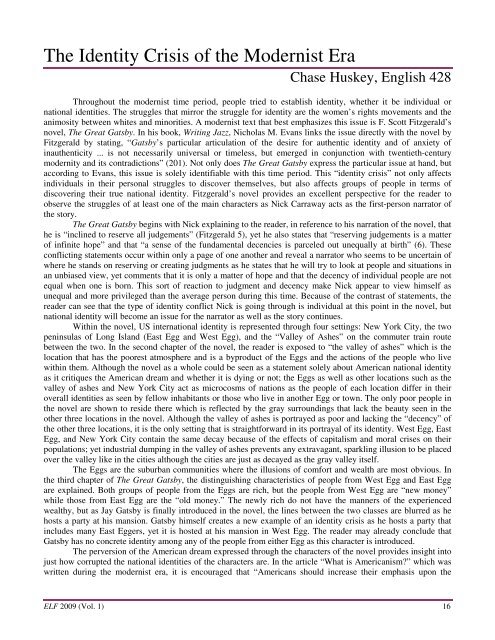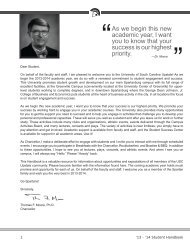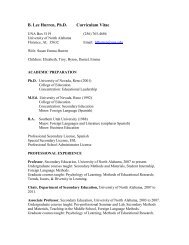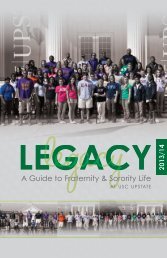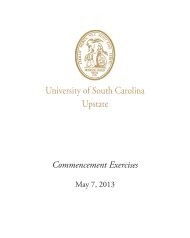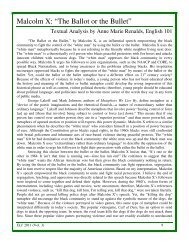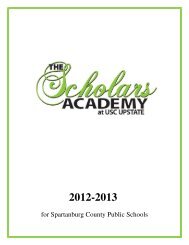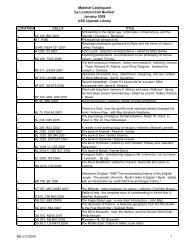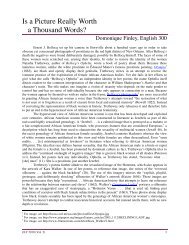The Identity Crisis of the Modernist Era
The Identity Crisis of the Modernist Era
The Identity Crisis of the Modernist Era
You also want an ePaper? Increase the reach of your titles
YUMPU automatically turns print PDFs into web optimized ePapers that Google loves.
principle implied in <strong>the</strong> foregoing, that <strong>the</strong> final standard <strong>of</strong> life, whe<strong>the</strong>r <strong>of</strong> individuals, <strong>of</strong> minor groups, or <strong>of</strong>nations is not material but moral.” <strong>The</strong> article continues discussing what true success is by stating,<strong>The</strong> measurement <strong>of</strong> success <strong>of</strong> living, thus far, is <strong>the</strong> kind <strong>of</strong> people we are—not <strong>the</strong> kind <strong>of</strong>people that we all are, considering that whe<strong>the</strong>r we will or no we are collectively engaged in anadventure <strong>of</strong> realizing <strong>the</strong> potentialities <strong>of</strong> persons, and that <strong>the</strong>se potentialities are realized in <strong>the</strong>highest degree, not in <strong>the</strong> most notable achievements <strong>of</strong> segregated personalities, but in <strong>the</strong>teamwork between persons which gives to each <strong>the</strong> most aid from all, and to all <strong>the</strong> most aid fromeach in <strong>the</strong> universal task <strong>of</strong> achieving higher human values. (“What is Americanism?” 485)According to this article, Americanism is <strong>the</strong> national identity <strong>of</strong> all Americans as it should be. Moralachievements such as higher human values should be <strong>the</strong> standards for success, not material gains. Althoughcapitalism is a huge part <strong>of</strong> <strong>the</strong> American society and dream, it has corrupted <strong>the</strong> environments <strong>of</strong> <strong>the</strong> characters in<strong>The</strong> Great Gatsby. Not only have <strong>the</strong>ir values and desires become strictly material, but morality has becomealmost nonexistent as it has become overshadowed by material gain and desire. <strong>The</strong> lack <strong>of</strong> true Americanism asdefined and encouraged by <strong>the</strong> article shows just how misguided <strong>the</strong> people <strong>of</strong> <strong>the</strong> Eggs are in not only individualidentity, but also national identity. <strong>The</strong>y are striving for what <strong>the</strong>y believe is <strong>the</strong> American dream, but <strong>the</strong>ir questfor it distorts <strong>the</strong>ir identities as Americans since <strong>the</strong> view <strong>of</strong> Americanism by some during <strong>the</strong> modernist era wasone <strong>of</strong> moral growth instead <strong>of</strong> solely material growth.However, <strong>the</strong>re were opposing views to this “moral Americanism” as seen in a supplement to <strong>the</strong> “Whatis Americanism?” article that appeared only two months after <strong>the</strong> main article in March 1915. In this supplement,emphasis is put onto labor group representatives and Americanism is described in a way much similar to that <strong>of</strong><strong>the</strong> way <strong>the</strong> characters <strong>of</strong> Fitzgerald’s novel would have most likely defined it. <strong>The</strong> quote “This is Americanism!”is used after <strong>the</strong> author continuously provides examples from America’s history to support his argument for <strong>the</strong>definition <strong>of</strong> <strong>the</strong> term. This definition is clearly stated as “To a lesser extent elsewhere, it is capitalism, butnowhere else, without an uprising, has it reached <strong>the</strong> perfection attained in <strong>the</strong> land <strong>the</strong> portals <strong>of</strong> which areguarded by <strong>the</strong> Statue <strong>of</strong> Liberty” (“What is Americanism? Supplement” 614). This view sees capitalism as <strong>the</strong>driving force for what <strong>the</strong> American dream truly is and could be used to support <strong>the</strong> claim that <strong>the</strong> characters in<strong>the</strong> novel have completely stable national identities regardless whe<strong>the</strong>r <strong>the</strong>ir individual identities are stable or not.Ano<strong>the</strong>r article that supports <strong>the</strong> idea that perhaps <strong>the</strong> national identities <strong>of</strong> <strong>the</strong> characters are stable issimply titled, “Nationalism.” In this article, S. Gale Lowrie writes that individuals, whe<strong>the</strong>r <strong>the</strong>y be states orpeople, must conform to <strong>the</strong> greater nation. He quotes a man named Pr<strong>of</strong>essor Holcomb who says that “A nationis a body <strong>of</strong> people united by a common sentiment <strong>of</strong> nationality.” Lowrie continues by writing that <strong>the</strong> nation“springs from a common heritage <strong>of</strong> memories and is a mutual feeling which binds members irrespective <strong>of</strong>differences in religion, economic interests, or social position” (Lowrie, 45). Although this argument does notspeak for <strong>the</strong> concept <strong>of</strong> capitalism specifically, it suggests that nationalism and its true definition lies with <strong>the</strong>feelings <strong>of</strong> multiple individuals united toge<strong>the</strong>r regardless <strong>of</strong> <strong>the</strong>ir individual identities.Within <strong>the</strong> novel, <strong>the</strong> lack <strong>of</strong> a common social heritage drives <strong>the</strong> characters to erase and reinvent <strong>the</strong>iridentities and <strong>the</strong>ir pasts. <strong>The</strong> fourth chapter <strong>of</strong> Fitzgerald’s novel recalls <strong>the</strong> story <strong>of</strong> Jay Gatsby’s past in whichGatsby claims to be <strong>the</strong> son <strong>of</strong> wealthy, deceased parents and lists many accomplishments that he has donethroughout <strong>the</strong> course <strong>of</strong> his life so far. Nick had first gotten <strong>the</strong> impression that Gatsby had a huge hope for <strong>the</strong>future, but <strong>the</strong> capitalist ideals expressed by Gatsby in this chapter quickly overshadow that aspect <strong>of</strong> hispersonality until <strong>the</strong> connection to Daisy Buchanan is revealed. Once Nick discovers that Gatsby is in love withDaisy, an aspect <strong>of</strong> happiness that is not material is introduced that is expressed through Jay Gatsby as a changedescribed by Nick as “simply confounding” (94). As Nick recalls, Gatsby’s true name was once James Gatzbefore he changed it to become a yacht assistant to a man named Dan Cody. In fact James Gatz had dropped out<strong>of</strong> school and been a janitor prior to becoming Cody’s assistant. Later, Cody died and left Gatsby an inheritance,but Gatsby was unable to claim it due to Cody’s mistress interfering. From that day forward, Jay Gatsby decidedto achieve <strong>the</strong> American dream and live a better life by becoming a successful and wealthy man, despite hisearlier life which was quite <strong>the</strong> opposite.As <strong>the</strong> novel continues, <strong>the</strong> reader learns that <strong>the</strong> luxurious parties that Gatsby holds for <strong>the</strong> wealthy <strong>of</strong>both West and East Eggs were only a ruse. Despite <strong>the</strong>ir capitalist appearances, <strong>the</strong>y were only tools to acquire animmaterial desire: Daisy Buchanan. This revelation makes Jay Gatsby perhaps <strong>the</strong> greatest example <strong>of</strong> an identitycrisis in <strong>the</strong> novel. Nothing <strong>the</strong> man says or does means what it seems. Not only has Gatsby changed his name,ELF 2009 (Vol. 1) 17
public personality, and lifestyle; but everything he does now has double meanings. His quest for <strong>the</strong> Americandream seems capitalist in nature, but it is for an immaterial purpose once that illusion is broken. His desire forwealth is a tactic used to achieve what he considers success, which is to win Daisy’s heart. This type <strong>of</strong> success,although not exactly moral, is immaterial and supports <strong>the</strong> argument for Americanism being a moral standard <strong>of</strong>living. Although capitalism is a factor in Gatsby’s success, it is not <strong>the</strong> driving force; <strong>the</strong>refore, it is notAmericanism according to him.<strong>The</strong> final moments <strong>of</strong> <strong>the</strong> novel begin with <strong>the</strong> death <strong>of</strong> Jay Gatsby. When Nick finds him floating dead inhis own pool and muses about <strong>the</strong> world that Gatsby may have discovered if he had finally realized that his dreamwas a hopeless cause. <strong>The</strong> statement, “A new world, material without being real, where poor ghosts, breathingdreams like air, drifted fortuitously about” (Fitzgerald 169). Although Nick is literally describing <strong>the</strong> worldGatsby may have reluctantly discovered in his final moments, <strong>the</strong> text actually describes Gatsby as an individualas well. Although he sought <strong>the</strong> immaterial, he has become materialistic in <strong>the</strong> new world <strong>of</strong> West Egg. He hadchanged his name and was not real and now he was only a name, a ghost <strong>of</strong> who he once was during life. At <strong>the</strong>end <strong>of</strong> <strong>the</strong> novel, Nick regains sight <strong>of</strong> Americanism and moves back to <strong>the</strong> Midwest because <strong>of</strong> <strong>the</strong> lack <strong>of</strong>morals <strong>of</strong> <strong>the</strong> Eggs. <strong>The</strong> “body <strong>of</strong> people united as a nation” as described by Lowrie has broken as everyonemoves <strong>the</strong>ir separate ways and now even “national” identities are in crisis.Nick fur<strong>the</strong>r raises this conflict between capitalism and morality in terms <strong>of</strong> national identity andAmericanism at <strong>the</strong> end <strong>of</strong> <strong>the</strong> novel. By stating that Tom and Daisy “retreated back into <strong>the</strong>ir money or <strong>the</strong>ir vastcarelessness or whatever it was that kept <strong>the</strong>m toge<strong>the</strong>r, and let o<strong>the</strong>r people clean up <strong>the</strong> mess <strong>the</strong>y had made,”Nick creates a perspective that perhaps wealth can take <strong>the</strong> place <strong>of</strong> morality in defining <strong>the</strong> identity <strong>of</strong> anindividual. <strong>The</strong> article and supplement titled “What is Americanism?” provides insight into an issue that wasoccurring back in <strong>the</strong> early twentieth century during <strong>the</strong> modernist era. As <strong>the</strong> United States was undergoing massdevelopment and improvements following <strong>the</strong> First World War, it is easy to consider that a struggle betweenmaterial wealth and morality would develop. <strong>The</strong> ego <strong>of</strong> <strong>the</strong> nation was also developing at this time as schoolswere teaching nationalistic ideas and had an “emphasis on citizenship” in which <strong>the</strong>y taught <strong>the</strong> importance <strong>of</strong>being a good citizen (Pierce 119). Pierce also comments that this national growth was nothing new as nationalismhad always “been conditioned by contemporary social, economic, and political thought” even before <strong>the</strong> CivilWar (117). This conflicts with <strong>the</strong> view that Evans held decades later in which he stated that <strong>the</strong> issue <strong>of</strong> identityin <strong>the</strong> modernist era was not exactly timeless, but ra<strong>the</strong>r unique to this era in American history. Could <strong>the</strong> reaction<strong>of</strong> struggling between morals and material possessions really be a phenomenon that occurred only in thisparticular era <strong>of</strong> national growth? No, but <strong>the</strong> particular historical context raised <strong>the</strong> issue to prominence andsparked a modernist crisis <strong>of</strong> identity.<strong>The</strong> issue <strong>of</strong> identity was perhaps such a historically-specific phenomenon because <strong>of</strong> <strong>the</strong> fact that <strong>the</strong>United States was still a young country and <strong>the</strong> First World War had been <strong>the</strong> first opportunity for <strong>the</strong>m to enter<strong>the</strong> international arena. <strong>The</strong> identity <strong>of</strong> <strong>the</strong> nation as a whole seemed to reflect those <strong>of</strong> <strong>the</strong> individual identitiesthat composed it, which supports <strong>the</strong> claim about unity among peoples by Lowrie in “Nationalism.” <strong>The</strong> unity <strong>of</strong>peoples is also expressed in an article by Arthur Feiler, titled “Economic Nationalism,” albeit in a differentcontext. In his article, his discussion links <strong>the</strong> ideas <strong>of</strong> morality to <strong>the</strong> development <strong>of</strong> <strong>the</strong> capitalism <strong>of</strong> <strong>the</strong>country during this time period. According to him, <strong>the</strong> “spiritual attitude” <strong>of</strong> <strong>the</strong> country that included <strong>the</strong> idea <strong>of</strong>free trade became known as “economic nationalism” (Feiler 203). As <strong>the</strong> article continues, he explains that <strong>the</strong>nation still undergoes post-war problems twenty years after <strong>the</strong> First World War ended. However, America is not<strong>the</strong> only country enduring a deep sense <strong>of</strong> nationalism because <strong>of</strong> <strong>the</strong> war. According to Lowrie, national identityis formed by <strong>the</strong> union <strong>of</strong> individual identities. Feiler uses this idea to relate nationalistic emotion to <strong>the</strong> growth <strong>of</strong>state powers in <strong>the</strong> economy <strong>of</strong> <strong>the</strong> United States as well as <strong>the</strong> growth <strong>of</strong> private economic interests. As bothtypes <strong>of</strong> identities develop, so does <strong>the</strong> capitalism <strong>of</strong> <strong>the</strong> country.So how does <strong>The</strong> Great Gatsby engage and respond to <strong>the</strong> issue <strong>of</strong> identity in <strong>the</strong> modernist era? Afteranalyzing <strong>the</strong> characters and locations <strong>of</strong> <strong>the</strong> text, <strong>the</strong> reader will undoubtedly notice <strong>the</strong> struggle betweenmorality and materialism at least in <strong>the</strong> character <strong>of</strong> Jay Gatsby. His attainment <strong>of</strong> vast wealth and popularity areresults <strong>of</strong> a quest for <strong>the</strong> heart <strong>of</strong> a woman named Daisy Buchanan who is also a key to <strong>the</strong> capitalist class. Thisparticular series <strong>of</strong> actions parallels what Feiler was stating about capitalism taking root in <strong>the</strong> “spiritual attitude”<strong>of</strong> <strong>the</strong> nation in his article. Capitalism and material wealth may have been <strong>the</strong> major outcomes <strong>of</strong> bothcircumstances, but <strong>the</strong>y had begun merely as factors in a quest for something immaterial. However, <strong>the</strong> character<strong>of</strong> Gatsby diverges from a parallel with America once one looks at <strong>the</strong>ir search for a place in <strong>the</strong> world. During<strong>the</strong> modernist era, <strong>the</strong> United States was still trying to find it place in <strong>the</strong> world especially since a large proportionELF 2009 (Vol. 1) 18
<strong>of</strong> <strong>the</strong> world fought in WWI. When <strong>the</strong> reader is exposed to Gatsby’s life story and his search for a place in <strong>the</strong>world in <strong>the</strong> sixth chapter <strong>of</strong> <strong>the</strong> novel, he or she is introduced to a serious identity crisis that is not onlyindividual, but also regional and national. Jay Gatsby is revealed to be going by a name that he was not born withand began his work life as a janitor <strong>the</strong>n a yacht assistant, two jobs that rarely result in capitalist success. Hisparties in West Egg with East Eggers combine both “old money” and “new money” to expose a regional identitycrisis as Gatsby does not identify himself as a member <strong>of</strong> ei<strong>the</strong>r Egg’s. As for <strong>the</strong> question <strong>of</strong> national identity, <strong>the</strong>four locations act as microcosms <strong>of</strong> nations <strong>the</strong>mselves. <strong>The</strong> Eggs and New York City are revealed to be beautifulon <strong>the</strong> outside, but moral disaster areas as one digs deeper. <strong>The</strong> novel on <strong>the</strong> whole critiques <strong>the</strong> state <strong>of</strong> allnational identity, including that <strong>of</strong> <strong>the</strong> United States. Most may have seemed successful at that time as <strong>the</strong>y wererecovering from WWI, but deep down, <strong>the</strong>y lacked significant moral values and social coherence.<strong>The</strong> idea <strong>of</strong> Americanism brought up in <strong>The</strong> American Journal <strong>of</strong> Sociology questions <strong>the</strong> notion thatAmericanism is <strong>the</strong> act <strong>of</strong> striving for higher moral values. In this article, America’s use <strong>of</strong> capital to get out <strong>of</strong>situations and as its main driving force to achieve its goals is an exact mirror to <strong>the</strong> description Nick gives <strong>of</strong> bothTom and Daisy. <strong>The</strong>se two individuals are portrayed by Nick as finding comfort from <strong>the</strong>ir mistakes by escapinginto <strong>the</strong>ir money. Yet Nick’s rejection <strong>of</strong> Tom and Daisy shows <strong>the</strong> novel is critiquing pure materialism. As <strong>the</strong>novel ends, Nick’s decision to move back to his home in <strong>the</strong> Midwest reveals a tentative moral identity forNick—although he denies it. This movement to <strong>the</strong> west also relates to <strong>the</strong> movement to <strong>the</strong> west side <strong>of</strong> <strong>the</strong>country during an earlier time when America was first looking westward to expand its horizons. Although <strong>the</strong>separation <strong>of</strong> <strong>the</strong> individual identities <strong>of</strong> <strong>the</strong> characters results in a separation <strong>of</strong> <strong>the</strong> “national” identity <strong>of</strong> <strong>the</strong>microcosms <strong>of</strong> <strong>the</strong>ir cities, not all hope is lost as Nick looks to <strong>the</strong> west. Perhaps this is a statement by Fitzgeraldthat even if America loses sight <strong>of</strong> its true identity and becomes corrupt, that <strong>the</strong>re is still hope for <strong>the</strong> future and<strong>the</strong> American dream.Works CitedEvans, Nicholas M. Writing Jazz: Race, Nationalism, and Modern Culture in <strong>the</strong> 1920s. New York: Garland,2000. Print.Feiler, Arthur. “Economic Nationalism.” Annals <strong>of</strong> <strong>the</strong> American Academy <strong>of</strong> Political and Social Science 180.1(1935): 203-206. JSTOR. Web. 2 Dec. 2008.Lowrie, S. Gale. “Nationalism.” International Journal <strong>of</strong> Ethics 41.1 (1930): 35-49. JSTOR. Web. 2 Dec. 2008.Pierce, Bessie Louise. “<strong>The</strong> School and <strong>the</strong> Spirit <strong>of</strong> Nationalism.” Annals <strong>of</strong> <strong>the</strong> American Academy <strong>of</strong> Politicaland Social Science 175.1 (1934): 117-122. JSTOR. Web. 2 Dec. 2008.“What is Americanism?” <strong>The</strong> American Journal <strong>of</strong> Sociology 20.4 (1915): 433-486. JSTOR. Web. 2 Dec. 2008.“What is Americanism? Supplement.” <strong>The</strong> American Journal <strong>of</strong> Sociology 20.5 (1915): 613-628. JSTOR. Web. 2Dec. 2008.ELF 2009 (Vol. 1) 19


